Biology
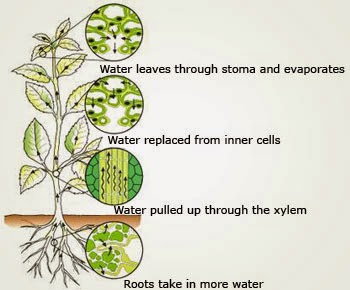 1. Multicellular organisms with small surface area to volume ratios need transport systems.
1. Multicellular organisms with small surface area to volume ratios need transport systems.
2. Water and mineral salts are transported through a plant in xylem vessels. Movement of water is a passive process in which the water moves down a water potential gradient from soil to air.
3. The energy for this process comes from the Sun, which causes evaporation of water from the wet walls of mesophyll cells in leaves. Water vapour in the air spaces of the leaf diff uses out of the leaf through stomata, in a process called transpiration. This loss of water sets up a water potential gradient throughout the plant.
4. Transpiration is an inevitable consequence of gaseous exchange in plants. Plants need stomata so that carbon dioxide and oxygen can be exchanged with the environment.
5. The rate of transpiration is affected by several environmental factors, particularly temperature, light intensity, wind speed and humidity. It is difficult to measure rate of transpiration directly, but water uptake can be measured using a potometer.
6. Plants that are adapted to live in places where the environmental conditions are likely to cause high rates of transpiration, and where soil water is in short supply, are called xerophytes. They have often evolved adaptations that help to reduce the rate of loss of water vapour from their leaves.
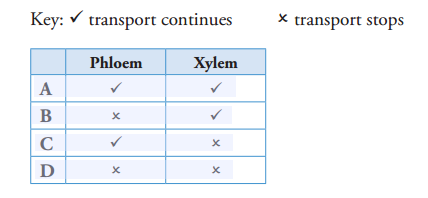
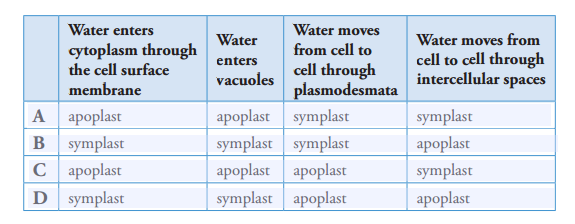
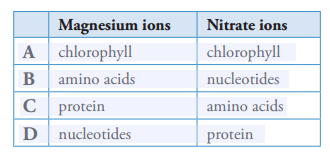
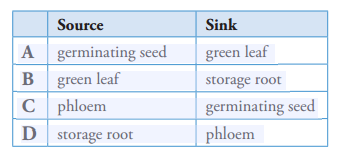
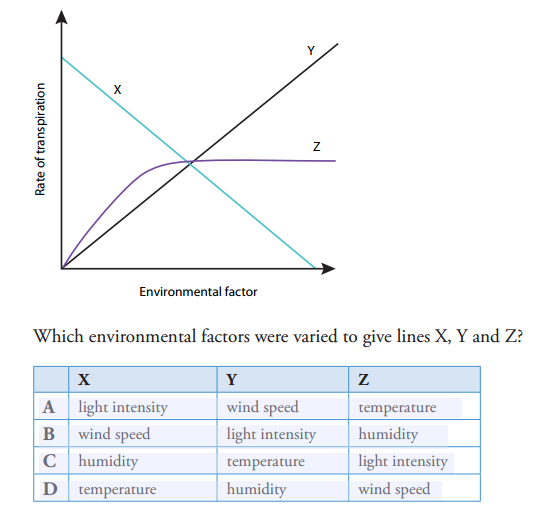
- Phloem & Xylem
Are Phloem and Xylem Similar? What are the Differences? Similarities: Phloem and xylem are tissues in a plant that transport food and water. Both are vascular tissues and when they work together to effectively transport food, water and minerals they form...
- #41 Transport In Phloem
The movement of substances in phloem tissue is called translocation. The main substances that are moved are sucrose and amino acids, which are in solution in water. These substances have been made by the plant and are called assimilates. Phloem...
- #40 Movement Of Water And Minerals In The Xylem
Most plants secure the water and minerals they need from their roots. The path taken is: soil -> roots -> stems -> leaves. The minerals (e.g., K+, Ca2+) travel dissolved in the water. Water and minerals enter the root by separate paths which...
- #39 Structure Of Transport Tissues In Plants
Plants have 2 transport systems: xylem: transports water and inorganic ions from the roots to the leaves.phloem: transports food made in the plant (sucrose and amino acids) from the leaves to the rest of the plant. Both of...
- #38.2 Transport In Multicellular Plants - Syllabus 2016
7.1 Structure of transport tissues 7.2 Transport mechanisms Flowering plants do not have compact bodies like those of animals. Leaves and extensive root systems spread out to obtain the light energy, water, mineral...
Biology
#42 Summary of Transport in multicellular plants

2. Water and mineral salts are transported through a plant in xylem vessels. Movement of water is a passive process in which the water moves down a water potential gradient from soil to air.
3. The energy for this process comes from the Sun, which causes evaporation of water from the wet walls of mesophyll cells in leaves. Water vapour in the air spaces of the leaf diff uses out of the leaf through stomata, in a process called transpiration. This loss of water sets up a water potential gradient throughout the plant.
4. Transpiration is an inevitable consequence of gaseous exchange in plants. Plants need stomata so that carbon dioxide and oxygen can be exchanged with the environment.
5. The rate of transpiration is affected by several environmental factors, particularly temperature, light intensity, wind speed and humidity. It is difficult to measure rate of transpiration directly, but water uptake can be measured using a potometer.
6. Plants that are adapted to live in places where the environmental conditions are likely to cause high rates of transpiration, and where soil water is in short supply, are called xerophytes. They have often evolved adaptations that help to reduce the rate of loss of water vapour from their leaves.
7. Water enters the plant through root hairs by osmosis. Water crosses the root either through the cytoplasm of cells (the symplast pathway) or via their cell walls (the apoplast pathway), and enters the dead, empty xylem vessels. It also moves across the leaf by symplast and apoplast pathways.
8. Water moves up xylem vessels by mass flow, as a result of pressure diff erences caused by loss of water from leaves by transpiration. Root pressure can also contribute to this pressure diff erence.
9. Mineral salts are essential nutrients. Examples are nitrate, which is needed for the synthesis of a wide variety of organic compounds, and magnesium, which is a constituent of chlorophyll.
10. Translocation of organic solutes such as sucrose occurs through living phloem sieve tubes. The
phloem sap moves by mass flow from a region known as the source to a region known as the sink. Sucrose is produced at the source (e.g. photosynthesising leaves) and used at the sink (e.g. a flower or a storage organ).
11. Mass flow occurs as a result of pressure differences between the source and the sink. Active loading of sucrose into the sieve tubes at the source results in the entry of water by osmosis, thus creating a high hydrostatic pressure in the sieve tubes.
12. Both xylem vessels and phloem sieve tubes show unique structural features which are adaptations to their roles in transport.
1. Multiple-choice test
1. Which feature is seen in both sieve tube elements and xylem vessel elements?
A elongated cells arranged end to end
B end walls perforated by large pores
C lignified walls with pits
D thin lining layer of cytoplasm
2. Part of the stem of a plant is heated to kill living vascular tissues.
How will this treatment affect transport through phloem and xylem?

3. Which description is correct?
A Companion cells have no nuclei and are not metabolically active.
B Pits are part of the cellulose cell wall of a xylem vessel element where no lignin has been deposited.
C Sieve tube elements are dead and have no cytoplasm or organelles.
D The lignified wall of a xylem vessel element is an adaptation to the high pressure inside the element.
4 What is responsible for the upward movement of water in xylem vessels in plants?
A active loading of water against the water potential gradient in roots and osmosis in the xylem vessels
B increasing water potential at the top of the xylem vessels and osmosis in the roots
C decreasing water potential at the top of the xylem vessels and cohesion of water in the vessels
D translocation in the leaves and capillarity in the xylem vessels
5. The movement of water in the apoplast pathway takes place outside living cells, whereas the symplast pathway involves living cells.
What occurs in the apoplast and symplast pathways?

6. What may magnesium ions and nitrate ions be used to make in a plant?

7. Which of the following are adaptations shown by xerophytes?
1 leaves covered by hairs
2 leaves covered in a layer of wax
3 leaves reduced to spines
4 stems that store water
5 stomata sunken into pits
A 1, 2, 3, 4 and 5
B 1, 2 and 3 only
C 2, 3 and 4 only
D 1, 4 and 5 only
8 Translocation moves sucrose from sources to sinks.
Which row shows a source and a sink?

9 Which description of translocation is not correct?
A Loading sucrose into a sieve tube element increases the water potential of the sap inside it.
B Sucrose is actively loaded into a sieve tube element at a source through a companion cell.
C Sucrose is removed from a sieve tube element at a sink and converted into other sugars.
D When sucrose is loaded into a sieve tube element water follows, moving down a water potential gradient by osmosis.
10. The rate of transpiration from a plant was measured in different
conditions. One of three environmental factors was varied at a time.
The results are shown in the graph.

Answers to Multiple choice test
1. A
2. B
3. B
4. C
5. B
6. A
7. A
8. B
9. A
10. C
2. End-of-chapter questions
1 If sucrose is actively loaded into a sieve tube, which combination of changes take place in the sieve tube?

2 Which of the following rows correctly describes the hydrostatic pressure of the two types of elements?

3. The diagram shows the effect of light intensity on the rate of transpiration from the upper and lower epidermis of a leaf. Other environmental factors were kept constant. What could explain the differences in transpiration rates from the two surfaces?
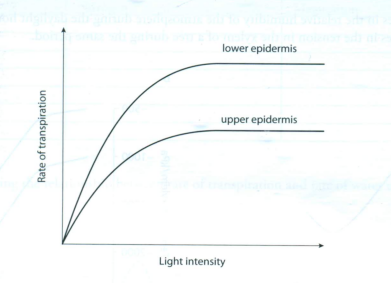 A Higherlight intensities are associated with higher temperatures.
A Higherlight intensities are associated with higher temperatures.
B Thepalisade mesophyll cells have fewer air spaces than the spongy mesophyll cells.
C Theupper epidermis has fewer stomata.
D Theupper epidermis is more exposed to light.
4. Explain how water moves from:
a the soil into a root hair cell.
b one root cortex cell to another.
c a xylem vessel into a leaf mesophyll cell.
5. Name three cell types found in:
i xylem
ii phloem.
b State the functions of the cell types you have named.
6 a The effect of increasing size on surface area: volume ratio can be shown most easily using a cube. Copy and complete the following table for cubes with the dimensions indicated (units are not needed):

b. Explain the relevance of these dimensions and ratios to transport in large multicellular organisms.
7. Arrange the following in order of water potential. Use the symbol > to mean 'greater than'.
dry atmospheric air; mesophyll cell; root hair cell; soil solution; xylem vessel contents
8. Figure a shows changes in the relative humidity of the atmosphere during the daylight hours of one day.
Figure b shows changes in the tension in the xylem of a tree during the same period.
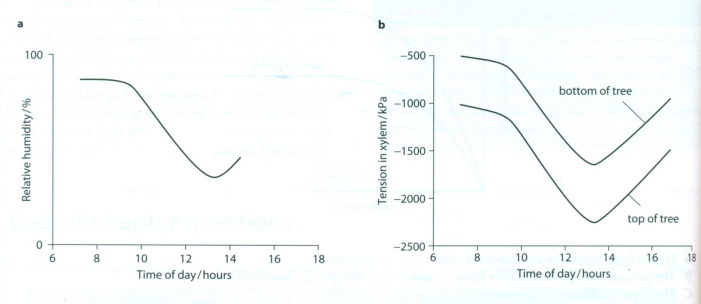
a Describe and explain the relationship between relative humidity and xylem tension.
b Describe and explain the differences observed in xylem tension between the top of the tree and the bottom of the tree.
9 An instrument called a dendrogram can be used to measure small changes in the diameter of a tree trunk.
Typically, the instrument reveals daily changes, with the diameter at its lowest during daylight hours and at its greatest at night.
Suggest an explanation for these observations.
10. Copy the table and place a tick or a cross in the appropriate box to indicate whether nitrogen or magnesium may be in the biochemicals shown.

11. The figure is a graph showing the relationship between rate of transpiration and rate of water uptake for a particular prlant.
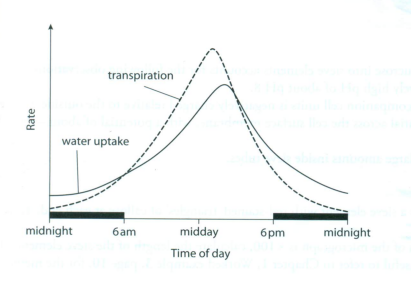
a Define the term transpiration. [2]
b State the two environmental factors which are most likely to be responsible for the changes in transpiration rateshown in the figure. [2]
c Describe the relationship between rate of transpiration and rate of water uptake shown in the figure. [2]
d Explainthe relationship. [4]
12 The figure is a light micrograph of a transverse section through the leaf of marram grass (Ammophila), a xerophytic plant.
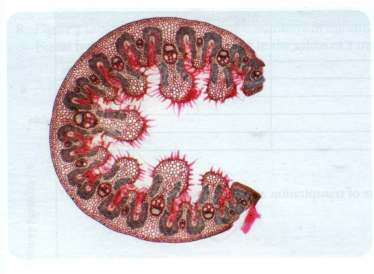
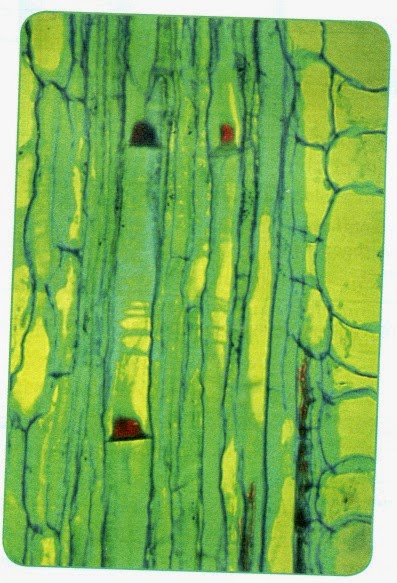
i Calculate how many sieve plates per metre a sucrose molecule would have to cross if it were travelling in the sieve tube identified in a above. Show your working. (Assume all the sieve elements are the same size as the one measured in the Figure above.) [2]
c Flow rates in sieve tubes range from 0.3 to 1.5 m h-1 and average about 1 m h-1.. If the flow rate in the sieve element shown in Figure above were 1 m h-1, how long would it take a sucrose molecule to travel through it? Show your working. [Total: 3]
15. Translocation of organic solutes takes place between sources and sinks.
a Briefly explain under what circumstances:
b Suggest two possible roles for glucose in each of the following sinks:
1 A
2 B
3 C
5 a i vessel elements; tracheids; parenchyma; fibres;
ii sieve (tube) elements; companion cells; parenchyma; fibres;
b vessel element: transport of water/support/transport of mineral ions;
tracheid: transport of water/support/transport of mineral ions;
sieve element: transport of, sucrose/organic solutes;
companion cells: loading/unloading, phloem (sieve element)/forms functional unit with sieve element;
parenchyma: storage/gas exchange;
fibres: support/mechanical strength;

b as size increases, volume increases faster than surface area;
therefore as size increases, the surface area : volume ratio decreases;
can no longer rely on diff usion to satisfy transport needs;
7 soil solution > root hair cell > xylem vessel contents
> mesophyll cell > dry atmospheric air
8 a the lower the relative humidity, the higher the tension/the lower the hydrostatic pressure, in the xylem;
more evaporation from leaf (mesophyll cells) when low relative humidity;
results in lower water potential in leaf (mesophyll cells);
therefore more water moves from xylem (vessels to replace water lost from leaf);
down a water potential gradient;
sets up tension in the xylem vessels;
b lowest/most negative, hydrostatic pressure is at the top of the tree;
because water is being lost at the top of the tree;
this sets up a tension which is greatest at the top of the tree;
there is a, hydrostatic pressure/tension, gradient in the xylem vessels;
some pressure is (inevitably) lost on the way down the tree;
9 transpiration/loss of water vapour/loss of water by evaporation, from the leaves occurs during the day;
because the stomata are open;
this results in tension in the xylem (vessels);
walls of xylem vessels are pulled slightly inwards/vessels shrink slightly;
overall eff ect is for diameter of whole trunk to, shrink/get smaller;
stomata close at night, so no transpiration at night;
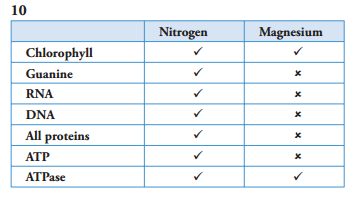
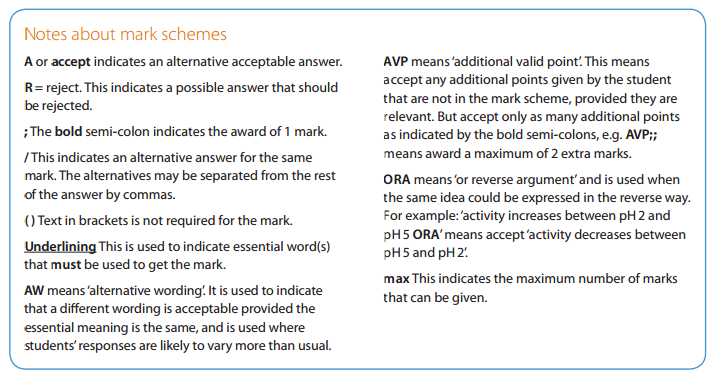
11 a the loss of water vapour;
from the leaves/from the surface of a plant; [2]
b light intensity; temperature; [2]
c rate of water uptake shows the same pattern as rate of transpiration; AW
but there is a time delay, with changes in rate of transpiration occurring before changes in water uptake; AW [2]
d transpiration causes water uptake;
loss of water (by transpiration) sets up a water potential gradient in the plant;
water potential in roots is lower than water potential in soil;
therefore water enters plant through roots;
time delay between rate of transpiration and rate of water uptake is due to time taken for effect of transpiration to be transmitted through the plant; AW [max. 4]
12 a thick cuticle (on lower epidermis/outer surface when rolled);
leaf rolled up (due to activity of hinge cells);
hairy upper epidermis/leaf is hairy;
stomata absent from lower epidermis/stomata only present in upper epidermis;
sunken stomata/stomata in pits/stomata in grooves (in upper epidermis); [max. 3]
b thick cuticle:
cuticle contains a (fatty and relatively) waterproof substance called cutin;
the thicker it is, the more eff ective;
leaf rolled up:
encloses a humid atmosphere/allows a humid atmosphere to build up;
hairy:
hairs trap a layer of (still) moist air next to the leaf;
stomata absent from lower epidermis:
reduces/prevents, transpiration from, lower epidermis/exposed surface;
sunken stomata:
allows a humid (still) atmosphere to build up around the stomata;
Allow 1 mark on one occasion only for ?reduces the steepness of the water potential gradient from leaf to air inside the (rolled) leaf? if relevant; [max. 6]
13
a hydrogen ions are actively transported out of the, sieve element/companion cell; [1]
b there are more hydrogen ions/there is a build-up of hydrogen ions, outside the sieve element?companion cell units compared with inside;
hydrogen ions are positively charged; [2]
c ATP is needed for the active transport of hydrogen ions out of the tubes; [1]
14 a actual length = observed length/magnifi cation,
A = I:M
observed length of sieve element = 51 mm (allow ±1 mm);
actual length = 51 mm/150 = 0.51 mm; accept
conversion of mm to ?m: answer = 510 ?m [3]
b i 1 metre = 1000 mm;
1000/0.51 = 1961(to nearest whole number);
or
1 metre = 1 000 000 ?m;
1 000 000/510 = 1961 (to nearest whole number); [2]
ii to maintain the pressure gradient inside the sieve tubes;
without the sieve plates the diff erent pressures at source and sink would quickly equilibrate; [max. 1]
iii sieve pores; [1]
c (sieve element is 0.51 mm long)
(1 hour = 3600 seconds)
3600 seconds to travel 1 metre;
therefore:
0.51/1000 × 3600 seconds to travel 0.51 mm;
= 1.8 seconds (to one decimal place);
Accept 510 ?m and 1 000 000 (?m) instead of 0.51 mm and 1000 (mm). [3]
15 a when seed is forming/just after fertilisation; [1]
b germination; [1]
c young immature leaf/leaf that is still growing; [1]
d mature photosynthesising leaf; [1]
e when food is being accumulated/when storage organ is growing (in size)/developing/end of plant?s growing season/just before winter; [1]
f when plant starts to grow (using food from the storage organ); [1]
g i to make starch;
respiration; [2]
ii to make cellulose;
respiration; [2]
1 If sucrose is actively loaded into a sieve tube, which combination of changes take place in the sieve tube?

2 Which of the following rows correctly describes the hydrostatic pressure of the two types of elements?

3. The diagram shows the effect of light intensity on the rate of transpiration from the upper and lower epidermis of a leaf. Other environmental factors were kept constant. What could explain the differences in transpiration rates from the two surfaces?

B Thepalisade mesophyll cells have fewer air spaces than the spongy mesophyll cells.
C Theupper epidermis has fewer stomata.
D Theupper epidermis is more exposed to light.
4. Explain how water moves from:
a the soil into a root hair cell.
b one root cortex cell to another.
c a xylem vessel into a leaf mesophyll cell.
5. Name three cell types found in:
i xylem
ii phloem.
b State the functions of the cell types you have named.

b. Explain the relevance of these dimensions and ratios to transport in large multicellular organisms.
7. Arrange the following in order of water potential. Use the symbol > to mean 'greater than'.
dry atmospheric air; mesophyll cell; root hair cell; soil solution; xylem vessel contents
8. Figure a shows changes in the relative humidity of the atmosphere during the daylight hours of one day.
Figure b shows changes in the tension in the xylem of a tree during the same period.

a Describe and explain the relationship between relative humidity and xylem tension.
b Describe and explain the differences observed in xylem tension between the top of the tree and the bottom of the tree.
9 An instrument called a dendrogram can be used to measure small changes in the diameter of a tree trunk.
Typically, the instrument reveals daily changes, with the diameter at its lowest during daylight hours and at its greatest at night.
Suggest an explanation for these observations.

11. The figure is a graph showing the relationship between rate of transpiration and rate of water uptake for a particular prlant.

a Define the term transpiration. [2]
b State the two environmental factors which are most likely to be responsible for the changes in transpiration rateshown in the figure. [2]
c Describe the relationship between rate of transpiration and rate of water uptake shown in the figure. [2]
d Explainthe relationship. [4]
[Total: 10]
12 The figure is a light micrograph of a transverse section through the leaf of marram grass (Ammophila), a xerophytic plant.

a Identify three xerophytic features visible in the light micrograph. [3]
b Explain how each of the features you have identified helps the plant to conserve water. [6]
[Total: 9]
13 Explain how active loading of sucrose into sieve elements accounts for the following observations:
a The phloem sap has a relatively high pH of about pH 8. [1]
b The inside of sieve element/companion cell units is negatively charged relative to the outside. (There is a difference in electrical potential across the cell surface membrane, with a potential of about -150 mV on the inside.) [2]
c ATP is present in relatively large amounts inside sieve tubes.[1]
[Total: 4]
14 Figure below shows a sieve element with red-stained 'triangles' of callose at each end. These triangles indicate the positions of the sieve plates.
14 Figure below shows a sieve element with red-stained 'triangles' of callose at each end. These triangles indicate the positions of the sieve plates.

a Assuming the magnification of the micrograph is x 100, calculate the length of the sieve element. Show your working. [3]
b Scientists were puzzled for many years by the fact that sieve plates were present in sieve elements, because sieve plates increase the resistance to flow. This contrasts with xylem vessel elements, which have open ends, redud resistance to flow.
i Calculate how many sieve plates per metre a sucrose molecule would have to cross if it were travelling in the sieve tube identified in a above. Show your working. (Assume all the sieve elements are the same size as the one measured in the Figure above.) [2]
ii What is the function of the sieve plates? [1]
iii What feature of the sieve plates allows materials to cross them? [1]
c Flow rates in sieve tubes range from 0.3 to 1.5 m h-1 and average about 1 m h-1.. If the flow rate in the sieve element shown in Figure above were 1 m h-1, how long would it take a sucrose molecule to travel through it? Show your working. [Total: 3]
15. Translocation of organic solutes takes place between sources and sinks.
a Briefly explain under what circumstances:
i a seed could be a sink [1]
ii a seed could be a source [1]
iii a leaf could be a sink [1]
iv a leaf could be a source [1]
ii a seed could be a source [1]
iii a leaf could be a sink [1]
iv a leaf could be a source [1]
v a storage organ could be a sink [1]
vi a storage organ could be a source. [1]
b Suggest two possible roles for glucose in each of the following sinks:
i a storage organ [2]
ii a growing bud. [2]
[Total: 10]
3. End-of-chapter answers
1 A
2 B
3 C
5 a i vessel elements; tracheids; parenchyma; fibres;
ii sieve (tube) elements; companion cells; parenchyma; fibres;
b vessel element: transport of water/support/transport of mineral ions;
tracheid: transport of water/support/transport of mineral ions;
sieve element: transport of, sucrose/organic solutes;
companion cells: loading/unloading, phloem (sieve element)/forms functional unit with sieve element;
parenchyma: storage/gas exchange;
fibres: support/mechanical strength;

b as size increases, volume increases faster than surface area;
therefore as size increases, the surface area : volume ratio decreases;
can no longer rely on diff usion to satisfy transport needs;
7 soil solution > root hair cell > xylem vessel contents
> mesophyll cell > dry atmospheric air
8 a the lower the relative humidity, the higher the tension/the lower the hydrostatic pressure, in the xylem;
more evaporation from leaf (mesophyll cells) when low relative humidity;
results in lower water potential in leaf (mesophyll cells);
therefore more water moves from xylem (vessels to replace water lost from leaf);
down a water potential gradient;
sets up tension in the xylem vessels;
b lowest/most negative, hydrostatic pressure is at the top of the tree;
because water is being lost at the top of the tree;
this sets up a tension which is greatest at the top of the tree;
there is a, hydrostatic pressure/tension, gradient in the xylem vessels;
some pressure is (inevitably) lost on the way down the tree;
9 transpiration/loss of water vapour/loss of water by evaporation, from the leaves occurs during the day;
because the stomata are open;
this results in tension in the xylem (vessels);
walls of xylem vessels are pulled slightly inwards/vessels shrink slightly;
overall eff ect is for diameter of whole trunk to, shrink/get smaller;
stomata close at night, so no transpiration at night;


11 a the loss of water vapour;
from the leaves/from the surface of a plant; [2]
b light intensity; temperature; [2]
c rate of water uptake shows the same pattern as rate of transpiration; AW
but there is a time delay, with changes in rate of transpiration occurring before changes in water uptake; AW [2]
d transpiration causes water uptake;
loss of water (by transpiration) sets up a water potential gradient in the plant;
water potential in roots is lower than water potential in soil;
therefore water enters plant through roots;
time delay between rate of transpiration and rate of water uptake is due to time taken for effect of transpiration to be transmitted through the plant; AW [max. 4]
[Total: 10]
12 a thick cuticle (on lower epidermis/outer surface when rolled);
leaf rolled up (due to activity of hinge cells);
hairy upper epidermis/leaf is hairy;
stomata absent from lower epidermis/stomata only present in upper epidermis;
sunken stomata/stomata in pits/stomata in grooves (in upper epidermis); [max. 3]
b thick cuticle:
cuticle contains a (fatty and relatively) waterproof substance called cutin;
the thicker it is, the more eff ective;
leaf rolled up:
encloses a humid atmosphere/allows a humid atmosphere to build up;
hairy:
hairs trap a layer of (still) moist air next to the leaf;
stomata absent from lower epidermis:
reduces/prevents, transpiration from, lower epidermis/exposed surface;
sunken stomata:
allows a humid (still) atmosphere to build up around the stomata;
Allow 1 mark on one occasion only for ?reduces the steepness of the water potential gradient from leaf to air inside the (rolled) leaf? if relevant; [max. 6]
[Total: 9]
a hydrogen ions are actively transported out of the, sieve element/companion cell; [1]
b there are more hydrogen ions/there is a build-up of hydrogen ions, outside the sieve element?companion cell units compared with inside;
hydrogen ions are positively charged; [2]
c ATP is needed for the active transport of hydrogen ions out of the tubes; [1]
[Total: 4]
A = I:M
observed length of sieve element = 51 mm (allow ±1 mm);
actual length = 51 mm/150 = 0.51 mm; accept
conversion of mm to ?m: answer = 510 ?m [3]
b i 1 metre = 1000 mm;
1000/0.51 = 1961(to nearest whole number);
or
1 metre = 1 000 000 ?m;
1 000 000/510 = 1961 (to nearest whole number); [2]
ii to maintain the pressure gradient inside the sieve tubes;
without the sieve plates the diff erent pressures at source and sink would quickly equilibrate; [max. 1]
iii sieve pores; [1]
c (sieve element is 0.51 mm long)
(1 hour = 3600 seconds)
3600 seconds to travel 1 metre;
therefore:
0.51/1000 × 3600 seconds to travel 0.51 mm;
= 1.8 seconds (to one decimal place);
Accept 510 ?m and 1 000 000 (?m) instead of 0.51 mm and 1000 (mm). [3]
[Total: 10]
15 a when seed is forming/just after fertilisation; [1]
b germination; [1]
c young immature leaf/leaf that is still growing; [1]
d mature photosynthesising leaf; [1]
e when food is being accumulated/when storage organ is growing (in size)/developing/end of plant?s growing season/just before winter; [1]
f when plant starts to grow (using food from the storage organ); [1]
g i to make starch;
respiration; [2]
ii to make cellulose;
respiration; [2]
[Total: 10]
- Phloem & Xylem
Are Phloem and Xylem Similar? What are the Differences? Similarities: Phloem and xylem are tissues in a plant that transport food and water. Both are vascular tissues and when they work together to effectively transport food, water and minerals they form...
- #41 Transport In Phloem
The movement of substances in phloem tissue is called translocation. The main substances that are moved are sucrose and amino acids, which are in solution in water. These substances have been made by the plant and are called assimilates. Phloem...
- #40 Movement Of Water And Minerals In The Xylem
Most plants secure the water and minerals they need from their roots. The path taken is: soil -> roots -> stems -> leaves. The minerals (e.g., K+, Ca2+) travel dissolved in the water. Water and minerals enter the root by separate paths which...
- #39 Structure Of Transport Tissues In Plants
Plants have 2 transport systems: xylem: transports water and inorganic ions from the roots to the leaves.phloem: transports food made in the plant (sucrose and amino acids) from the leaves to the rest of the plant. Both of...
- #38.2 Transport In Multicellular Plants - Syllabus 2016
7.1 Structure of transport tissues 7.2 Transport mechanisms Flowering plants do not have compact bodies like those of animals. Leaves and extensive root systems spread out to obtain the light energy, water, mineral...
